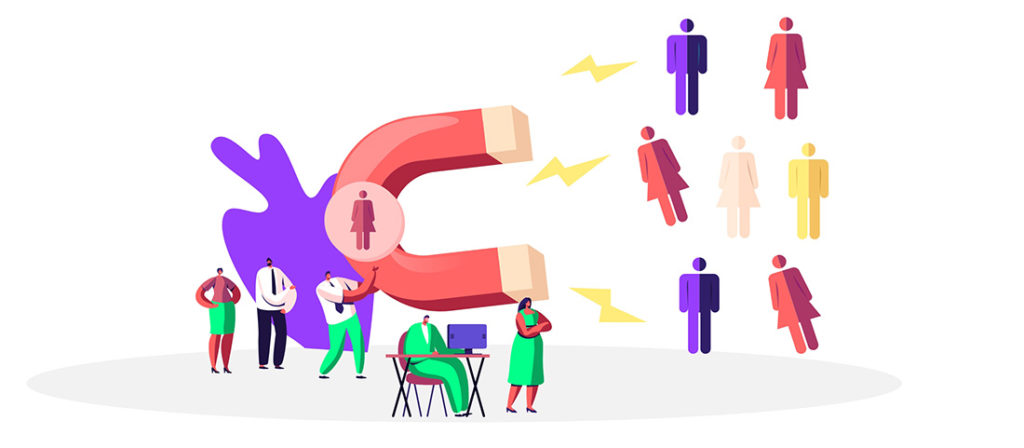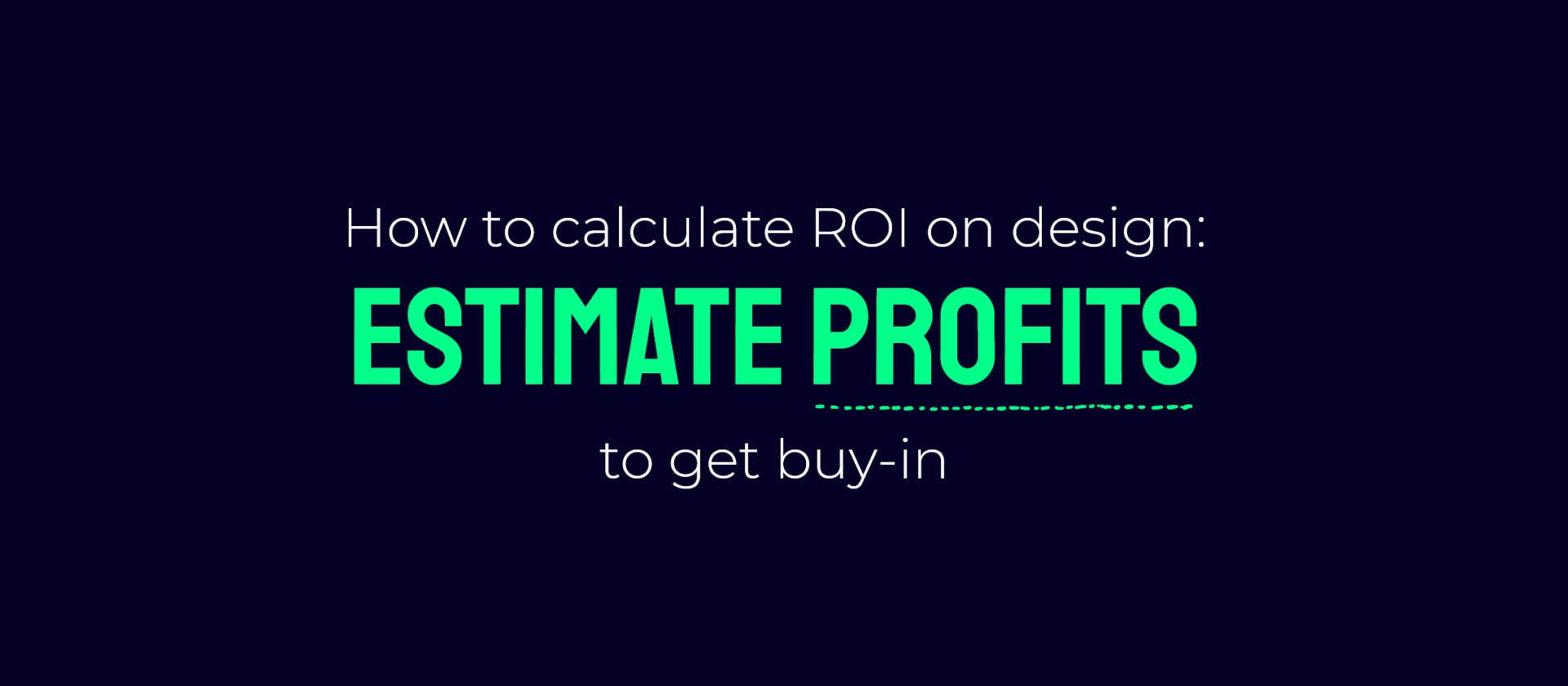Great design is not a luxury, it’s a differentiator, but how do you put its value into numbers? Calculating ROI on something as intangible as design can be a roadblock to getting the necessary budget. Find out how to estimate returns and prove your idea will benefit your business, and its profit sheet.
One of our recent goals at Buffalo 7 was to show the world what we can do. To show how we’re different to any other agency, and how we provide value.
But value, when it comes to something as intangible as design, is bloody difficult to quantify.
Yes, we’ve rebranded so our visual story now reflects the high quality of our work. We’ve overhauled our marketing and stunned the world with our capabilities, client testimonials, and downtime play projects. And we’ve continued to share our knowledge through our blog, client interactions, and by speaking at various external events.
We now show value at every interaction, but how does this all translate into real, quantifiable value for you? Ok, let’s call it what it is – cash. In this post, we’ll cover how to calculate ROI on a design project, so you can pitch your ideas with confidence.

Qualitative to quantitative
You know how it makes you feel to watch one of our before and after presentation transformation videos. I don’t even need to ask whether you’d rather present mind-blowing slides or crap ones. And I bet you could easily recall the feeling of frustration and embarrassment that happens when you suffer a presentation malfunction at a key moment.
It’s undeniable that what we do adds value. But how can you translate these qualitative, emotional reactions into straight-up figures? When you’re competing for a chunk of the company budget to get your presentation project approved, how can you show – in no uncertain terms – that it’ll all be financially worth it in the end?
The problem when it comes to calculating ROI on design
“You can’t manage what you don’t measure.”
Peter Drucker
You and I may understand there’s more to successful decisions than numbers, research and hypotheses – that, sometimes, you just need to listen to your gut. But when asked to stand in front of your Directors and make a business case for graphic design, you’ve got to go in with something stronger than your stomach.
When the big bosses are looking to make smart decisions that increase profits, it’s rare for graphic design to be their first port of call. This is why marketers need to learn to speak exec; to find practical, objective and rationalised arguments, backed up with cold, hard figures. It may seem like an impossible ask, but don’t you worry – we’ve got an easy framework for calculating ROI, as well as a few tricks up our sleeve, to get you fluent in no time.
1. Find your angle
Before you can calculate ROI, you need to know what you’re measuring. Just as you would any time you’re trying to be persuasive, you need to pitch your idea in a way that solves a problem for the audience. For your design project, this means aligning your solution with one – or more – existing business drivers and KPIs.
What is your company focusing on right now? What are the organisational goals you can help achieve with your design project? This is absolutely crucial if you want to show just how much design can benefit your company. However, it’s not uncommon for company goals to be something generic like, “deliver returns to shareholders”? How inspiring.
How to find your angle
Don’t panic. There are two key questions that will help you drill down and find the strongest argument for your design project:
What’s costing you money?
and
What could make you more money?
Let’s look at these in more detail.
What’s costing you money?
This is about identifying the inefficiencies in your existing processes, so that you can show how your design project will smooth them out and save the company money.
Are you losing valuable time making every presentation from scratch? Most salespeople spend 50+ hours every month on presentations, and a lot of that is time they could be using elsewhere. An intuitively-designed and robustly-built PowerPoint template, accompanied by a professional, hands-on training session, could recover a big chunk of lost time for everyone tasked with creating presentations in your company.
Are you losing valuable team members due to frustration and low engagement with the available marketing assets? Well-designed presentation assets would remove these frustrations, showing the company cares about each person’s success and senior management are listening to their pains. Not only does it cost between six- and nine-month’s salary to replace an employee, but employee engagement has also been shown to increase profits by 21%. These two figures together give a good argument for keeping employees invested and removing frustrations, to increase profits.
Does your company spend thousands every year in travel? According to Pace Productivity, the average salesperson spends 11% of their time travelling, which can get expensive for businesses. On-brand, professional webinar materials and digital brochures can make connections that count, no matter how physically distant you are from your prospective clients. This means salespeople gain back the time they used to use travelling, and the business saves thousands in fares.
What could make you more money?
This seems like a no brainer when it comes to calculating ROI, but there’s more to this angle than meets the eye. This question has two parts to it. Firstly, how could you attract and retain more customers?
Increase attraction
Did you know 54% of businesses lose half – or more – of the work they pitch for? This is an area where investing in design could increase revenue by a considerable amount. If you understand why you’re losing pitches, you can make your argument even more tailored, and even more persuasive. Consider reaching out to companies that decided not to buy into your business and ask for feedback to gain this insight.
If you aren’t sure why you’re not hitting the mark with your existing presentations, here are some issues we see time and time again.

Trust
When pitching, you have a very short window of time to convince your audience that they should partner with you. What you tell and show them has to be carefully crafted in order to instantly gain their trust.
Design can help establish credibility in a number of ways. In fact, visual appeal can be assessed in about 50 milliseconds, so getting the design of your presentation right will instantly make your business appealing in your audience’s eyes.
Ultimately, your audience needs to trust that the solution you’re pitching will work for them. Product showcases, when done right, can allow them to get up close and personal with your products, interact with the solution, and get a feel for how it can help them, establishing this trust. Don’t let all your hard work go to waste by letting poor presentation design distract from your product’s features and benefits.
Reach
Getting a meeting with a prospective client can take weeks of gentle nurturing, but there’s no guarantee the person who agrees to meet you is the person you need to speak with, or that you will make the sale on the first meeting. In fact, 80% of sales require an average of five follow ups, so you need to be thinking way beyond that first presentation.
Following up after a meeting with personalised, valuable content, such as a digital brochure or physical print document, can help you to move closer to that all-important sale, as well as reach people who weren’t in the room when you presented. The key is to add value and personalised messaging at every touchpoint, as 78% of consumers are more likely to work with a company that provides tailored content.
Connections
Not connecting with, or engaging, your audience could be the Achilles heel of your pitches. In fact, 46% of people say they disconnect from presentations, with the first attention drop out hitting at just 30 seconds in. Ouch.
Good design can grab your audience’s attention from the moment they walk into the room, and hold it until the very last slide. Using psychological trickery, such as contrast, movement, and proportion to draw the eye, a good designer knows exactly how to capture attention and imagination.
Well-designed menu systems can put your audience in control of the conversation, making them feel as though they’re already a part of your story. When you turn your presentation from a monologue to a dialogue, you’re more likely to see success.
Persuasion
An incredible 70% of people believe presentation skills to be critical to their role, and yet less than 25% have any presentation training at all.
Getting the story right is just one element of a persuasive presentation. Anyone in your company that presents needs to know the best way to deliver the story in a way that will resonate with the individuals in front of them. Get the design and the presenting right, and you’ll all be emerging from every meeting victorious.
Comprehension
Walking into pitches with crammed, unintelligible slides will not only lower engagement, but also understanding.
Design can turn the most complex messages into easy-to-understand visual masterpieces that slip seamlessly into the minds of those they meet. It takes just one-tenth of a second for your audience to get the sense of a visual scene, and 67% of people are persuaded by messaging with accompanying visuals. Transforming your copy-heavy slides into visual stories could see your company getting a slice of that persuasion pie.
Increase value
The second way you can make more money is by increasing the value, price, or frequency of purchase of whatever it is you’re selling.
As we all know by now, people don’t buy what you do, they buy why you do it. Great design can evoke emotive responses in your prospective clients that influence the value they attach to your products or services. Premium design holds connotations of quality, whereas poor design will reflect negatively on your company. And why would they pay out for poor quality?
When your brand is consistent across all touchpoints, people feel as though you have excellent attention to detail, they’re more likely to recognise and remember your business, and what you do is seen as more valuable. This is why consistent design has been shown to increase revenue by up to 23%.
Think outside the box
When thinking about what to measure, don’t just go for the obvious.
If time saving is your angle, think about what your sales team would do with all the extra time they’re not spending building presentations from scratch. Think about the increase in productivity the company will see from an engaged workforce.
And think beyond the immediate users. Think about all your IT team could achieve when they’re not being called in to deal with “PowerPoint issues” that can be traced back to poorly-designed templates. Think about how the marketing team will flourish, knowing every presentation that goes out the door is on brand, without having to check meticulously through each one.
Consider all knock-on effects when gathering your proof points. This is a multiplier effect to help quantify your impact.
But we’re still just working in sentiment. We’ve put it off long enough, it’s time to start calculating ROI.
2. Get your calculators out
Once you know where your greatest wins are, strap yourself in for some maths. A study by the Design Council discovered that every £100 a business spends on design increases turnover by £225, but we need to figure out the ROI for your unique project.
The calculations will be different for each angle, but – essentially – you’re looking to find the difference between where you are now, and where you will be.

Establish the status quo
First, find people in your organisation who can help you uncover the most important metrics. Try talking to Product Managers, sales and marketing teams, make friends with Jeff from accounts. Basically, talk to anyone who’s impacted by the way things are, to assign numbers to this problem.
For example, if you’ve identified a time-saving opportunity, find out how long the sales teams are spending building presentations from scratch. Then look into how long the marketing team are spending checking them. And how long IT spend talking them through the finer points of PowerPoint, and so on.
Or, if you’re focusing on making money, figure out how much you’ve lost in unsuccessful pitches over the last year. Don’t only include the money you could’ve generated from the client. Make sure to cover how much resource, travel, lead generation time went into getting that client to the meeting stage. How much investment was needed, only to lose them to a poorly-executed presentation.
Calculate the difference
Then, look externally. This is the hardest part. You need to estimate how much time a well-designed template will save you. Or how many more pitches you could win if your audience trusted you. Or how much you could increase Customer Lifetime Value if you reached more people in the company.
You may need to look at historical data, get expert opinions, look to similar companies who have done similar things. Basically, research the hell out of it to find those numbers. The keen-eyed among you will have noticed this blog post is full of useful data points to give you a head start.
Put your money where your research is
The reason we’re all here: what does that mean in Sterling? How much is the average user’s time worth? If they were spending that time doing more selling, how much more revenue would they bring into the business? How much less could you realistically spend on travel? How much could you boost Customer Lifetime Value by, if each of your customers believed your product to be premium?
Keep working through all the angles you identified in the first step, until each one has a cost associated with it.
After you’ve calculated ROI
It’s time to present your argument to the board. You have everything you need, but your work isn’t done yet. I don’t need to tell you that how you present your findings is just as important as what you present.
From calculating ROI to story time
Don’t overwhelm them with a wall of numbers. Turn your data into an emotive story. Show that you understand their problems and you have a solution, and the numbers to back it up. Align your objective with the company’s goals, providing them with a shortcut to glory.
Show your working
Don’t worry about your data being based on assumption, most business decisions are. Your Directors will be well versed in hypothetical business cases. Let them ask questions, challenge you, and have a conversation. This will only make them more invested.
Make them jealous
Present success stories from their greatest competition, or companies they respect. Throw in a gentle reminder that 73% of businesses invest in design to stand out from the competition. And if they’re not investing, they are that competition that’s blending into the crowd.
Alternatively, drop in this little nugget: Design Management Institute found that design-centric companies outperform the S&P index (the indicator of industry average performance) by 228% over a ten-year period. Find a design-centric example in your industry to invoke that motivating fear of missing out.
Start small
If the board still doesn’t seem ready to jump into a full design overhaul, start with a template to validate your theory. A PowerPoint template acts as the foundation for all future presentations. Every time you need to present, you’ve already got a head start. Templates are designed to be on brand and easy to use, creating consistency across your communications, and cutting out the hard work for your people.
Templates often require less design time than full presentation projects, and can be a low-cost way to dip your toe into the world of next-level presentations. If your initial experiment proves successful, you’ll have strong leverage to implement the desired change on a larger scale.
Calculating ROI is just one element of persuasion
Whatever your company wants to achieve, graphic design can help it get there. Now you have everything you need to back up sentiment with cash figures, leaving no stone unturned. We can’t wait for you to get in touch, once that design budget is yours for the spending.
If your company goals and focus expand beyond profits, calculating ROI might just be your first step. Read our article on getting buy-in for presentation projects to build out a fuller picture when pitching your idea.


